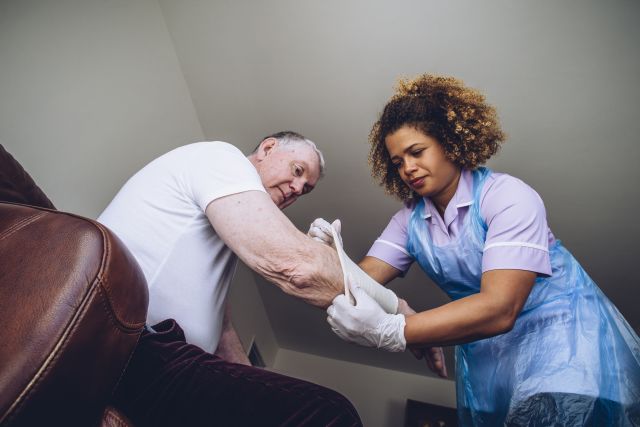Updated on October 3, 2023.
How quickly any wound heals depends on a number of factors, including your age, diet, medications, and health status. There’s also the wound itself: Where on your body was it sustained? How deep is it? How severe is it?
Generally speaking, most wounds—known as acute wounds—are expected to heal within a certain time frame, following a relatively predictable process. But what happens when a wound doesn’t heal, or when the process stalls in an unexpected way?
In these cases, the wound is considered to be chronic.
Underlying health conditions you may have—such as diabetes or circulation problems—usually combine with the characteristics of a wound to cause it to not heal normally, explains Rohini Sharma, MD, an infectious disease specialist at North Suburban Wound Care and Hyperbarics in Thornton, Colorado.
Likewise, the best treatment for chronic wounds will vary from one person to the next, depending on your individual traits and the unique features of the wound itself. Chronic wound treatment is typically an ongoing process, requiring the active participation of both the healthcare provider (HCP) and the patient, Dr. Sharma says.
What to expect from treatment for chronic wounds
Treatment for chronic wounds is typically multi-layered. It involves:
- Caring for the wound itself, making sure that it is cleaned and dressed while managing any related infections.
- Managing any underlying health conditions that are contributing to the delayed healing. This could involve helping patients with diabetes better manage their blood sugar levels, helping smokers quit, and helping people with poor diets eat more healthfully.
“You need to set long-term goals for the patient,” Sharma says. Chronic wounds can take months or years to heal. Managing them often requires regular visits to a wound care clinic. You may also need to make some lifestyle and behavioral changes.
“The wound clinic will help you get the support you need,” she says. “But you—the patient—are going to have to do your part.”
Underlying problems need to be addressed
Chronic wound treatment should include managing the factors that can contribute to a wound becoming chronic in the first place. With the help of your healthcare team, you may need to make some changes to your habits and lifestyle, including:
Controlling your blood sugar levels: If you have diabetes, keeping your blood sugar levels in check can help improve your circulation and blood vessel function. This can promote healing while decreasing your risk for infection.
Improving your diet: Malnutrition is a factor that can stall wound healing. Eating healthfully, such as by consuming adequate amounts of protein, not only improves your overall health but also bodily functioning, including wound healing.
Quitting smoking: Smoking is another factor that can hinder the body’s natural healing process, Sharma says. If you smoke, talk to your HCP about safe and effective ways to kick the habit.
Other factors that can contribute to stalled wound healing that your healthcare team will help you address include edema (swelling caused by excess fluid in the body’s tissues) and circulatory problems.
Cleaning and dressing chronic wounds
Another key part of a chronic wound treatment plan is making sure that your wound is properly cleaned and dressed, which may ease pain while helping to prevent infection.
Properly dressing a chronic wound also:
- Helps relieve itching
- Stops the wound from drying out
- Absorbs excess fluid that may come out of the wound
- Protects the wound from further damage
Most chronic wounds require regular cleaning, which should be done by a doctor, nurse, or other healthcare professional. They’ll typically rinse the wound with a saline solution and remove dead cells or inflamed tissue with a surgical instrument called a curette or a scalpel. It can be a painful process, so a topical numbing agent may be applied to the wound before the cleaning begins. The wound then gets a new dressing. Wound dressings may include foams or hydrogels.
How often a chronic wound needs to be cleaned and dressed depends on the wound itself and the type of dressing the healthcare team chooses, Sharma explains.
Some wounds that become infected may require more frequent cleaning and dressing, along with antibiotics.
Managing pain and discomfort
Living with chronic wounds—and tending to their cleaning and dressing—can be painful. It’s important to manage that pain in order to improve your quality of life and reduce the extent to which a chronic wound interferes with your day-to-day life and healthy habits, like getting adequate sleep, socializing, and exercising.
Over-the-counter (OTC) pain relievers like acetaminophen can help with mild to moderate pain. Non-steroidal anti-inflammatory drugs (NSAIDs, including aspirin and ibuprofen) may also be used in the short term, but be sure to check with your HCP about whether or not they are safe for you to take. If OTC formulas don’t provide enough relief, ask your HCP about stronger painkillers or a referral to a pain specialist.
When more extensive treatments are needed
Some chronic wounds require more aggressive therapies, such as surgery or skin grafts. “It’s not necessarily the severity of a wound alone that determines if aggressive therapy is needed,” Sharma explains. “It’s usually the overall characteristics of the wound.” Some of these treatment options include:
Skin grafts: A skin graft is a procedure in which a surgeon removes skin from one part of the body (usually the upper leg) and transplants it onto the wounded area. This may be a helpful solution for chronic wounds that are large or located in places that make applying a dressing difficult. Skin substitutes—which can provide temporary or permanent coverage for wounds and can help the body regenerate skin—may be an option in some cases.
Hyperbaric oxygen therapy (HBOT): HBOT involves increasing the delivery of oxygen to specific areas of tissue to improve wound healing. There’s evidence it aids the healing of chronic ulcers in people with diabetes, as well as chronic wounds that result from radiation therapy.
Vacuum-assisted closure: Also known as “negative pressure wound therapy,” this method uses suction to draw excess fluid out of a wound and to stimulate the growth of new tissue.
Platelet-rich plasma (PRP): Patients with diabetes who have slow-healing wounds on their feet may benefit from an infusion of autologous platelet-rich plasma, a preparation made from substances in the patient’s own blood. The high concentration of platelets—a component of blood that promotes clotting—can help heal chronic wounds.
Other surgical interventions: For wounds with deep infections, bony deformities, foreign bodies—or for injuries that involve blood vessels and that require stents—additional surgical approaches may be necessary.
Sharma advises patients not to think of these treatments as strictly last-line options for only the worst-of-the-worst cases. Clinicians may recommend them in a variety of scenarios when they make sense for the patient’s unique needs, she explains, such as if a wound has a deep infection or covers a wide area.
Because surgery and other aggressive treatments carry risks of their own, Sharma says her first approach is to try to help the wound heal itself by applying appropriate wound care products, compression therapy when needed, and keeping the wound clean and infection-free while supporting patients’ efforts to make lifestyle changes that will improve their overall health.
“More invasive therapies by themselves may not heal a chronic wound,” Sharma says. “All the other behavioral strategies—like improving diet and controlling diabetes—will still be necessary to optimize wound healing.”







